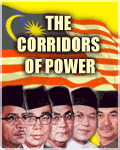Land of the Hornbills

Sarawak currently has 31 parliamentary and 71 state seats. Its population is made up from 30% Iban, 26% Chinese, 22% Malays, 8% Bidayuhs, 5.5% Melanaus and 5.5% Orang Ulu consisting of Kayans, Lun Bawangs, Kelabits, Kenyahs, Penans, Sebobs plus a few more smaller tribes. (Non Malaysians make up the remainder 3%.)
CORRIDORS OF POWER
Hakim Joe
Sarawak is considered one of the poorest and least developed states in Malaysia despite its abundance of natural resources including timber (world’s largest exporters of tropical hardwood timber), LNG (world’s second largest exporters of LNG together with Sabah) and petroleum.
The Alliance/BN has politically controlled the state since its inception in 1963. The first Chief Minister is of course the famous Datuk Amar Stephen Kalong Ningkan (from SNAP) until he was ousted in 1966 to be replaced by Datuk Penghulu Tawi Sli (former SNAP secretary) of Pesaka. Tun Abdul Rahman Ya’kub became the third CM in 1970 and governed Sarawak until he stepped down and was subsequently appointed as the Governor in 1981. The vacant CM seat then fell to the new president of Parti Pesaka Bumiputera Bersatu (PBB), Pehin Sri Haji Abdul Taib Mahmud (nephew of Tun Abdul Rahman Ya’kub). The rest is history.
The demographics of Sarawakians are something we should take note of. The majority of Ibans (Sea Dayaks) are Christians, so are the Bidayuhs (Land Dayaks), Kayans, Kelabits and Penans. The Melanaus are Muslims. So, in terms of segregating the religious faiths, it can be said that the majority of Sarawakians are non-Muslims and owing to its diversified mixture of different races and indigenous people, religious and racial tones are never employed during the political campaigning here.
Currently the four Sarawak political parties aligned to BN are Parti Pesaka Bumiputera Bersatu (PBB), Sarawak United People’s Party (SUPP), Sarawak Progressive Democratic Party (SPDP) and Sarawak People’s Party (PRS). The Sarawak National Party (SNAP) was expelled from BN in 2004.
The last time Sarawak held a state election was in 2006 where BN won 62 of the 71 contested seats. In 2001, BN won 60 of the 62 contested seats. The next state elections will be held before the 24th of April 2011. Let us analyse the results:
For BN, PBB won 35 seats, SUPP won 11 seats, SPDP won 8 seats and PRS also won 8 seats. For the opposition, PKR won 1 seat, SNAP won 1 seat, DAP won 6 seats and 1 seat went to an independent.
Of the 69 contested seats (2 were won uncontested by BN), 18 seats saw a winning majority increase for BN while 51 seats saw a swing to non-BN contestants. Meradong (N40) had the largest swing of 43.8% where DAP beat 4 other contestants while Satok (N8) recorded the lowest swing of a mere 0.5%. On the average, all the contested seats saw an average swing of 8.2% towards non-BN contestants.
Analysis shows that this event was precipitated by a swing of the Chinese votes from SUPP to other non-BN parties. Of the 9 seats that BN lost, 6 were SUPP incumbents. This election also witnessed BN fielding 15 Chinese contestants of which 6 lost. Of the remaining 9 seats which BN won, the declining majority exhibit a swing of 16.9% away from them. Overall, seats where BN nominated Chinese candidates showed a swing of 18.8% to the opposition.
What does this all mean? It means that even with an overall average swing of 8.2% to the opposition, BN still won 62 seats or 87.3% of the 71 seats. To have won the 9th state election on a simple majority, the opposition must have an average minimum swing of 12.9% (where 28 of the least majority BN won seats are instead won by the opposition by 1 or two votes) and the Chinese swing from 18.8% to 20.3%. Is this a lot? The required (minimum) 4.7% increase amounts to only 29,491 votes, or 12,746 BN voters changing allegiance.
Sarawak can be won over by the opposition and that is a fact as exhibited by the figures above. The 30% Iban voters holds the key to this goal. 10 seats which BN won were decided on a majority less than 1,000 votes (19 BN seats if less than 2,000 votes). 2011 is not that far a time in the future that Pakatan can dally until a later date before taking action to counter the BN monopoly.
At the very least, Pakatan can attempt to win enough seats (24 seats) to stop BN commanding a two-thirds majority in the Sarawak state assembly.

